|
The Reflex Retinas were Kodak's venture into Reflex cameras and quite successfully so as they were produced in large numbers, particularly the last model, the Reflex IV. They all had interchangeable lenses, the first Retina Reflex shared the Retina c mount with the Retina II/IIIc series, the other Reflex cameras had the same mount as the Retina IIIS. The great advantage of the Reflex cameras was that the image in the viewfinder was the image through the lens, so problems with parallax and the need for different viewfinders for different lenses were a thing of the past.
On the downside they tended to be rather bulky and mechanically complex.
Kodak Retina Reflex
This was the first Retina Reflex and it featured the same interchangeable lens system as the Retina C models (IIC and IIIC). In fact, all controls were rather similar so it would not take much time to get used to this camera if one had used a folding Retina before. The big difference was of course the replacement of the rangefinder with a through-the-lens viewfinder. One would focus (and frame the shot) using the reflection of the image on a ground glass, which also contained a small split-screen glass that greatly helped achieving the best possible focus.
The shutter action was a marvel of ingenuity but rather complex. First of all, upon cocking the shutter, the mirror would sweep into place and the shutter would open. Hence, the mirror had to also seal the film gate very effectively. Then, upon pushing the shutter release, the shutter would close, the mirror would swing back to its rest position, and only then the shutter would fire. This all happened in the blink of an eye, quite an achievement!
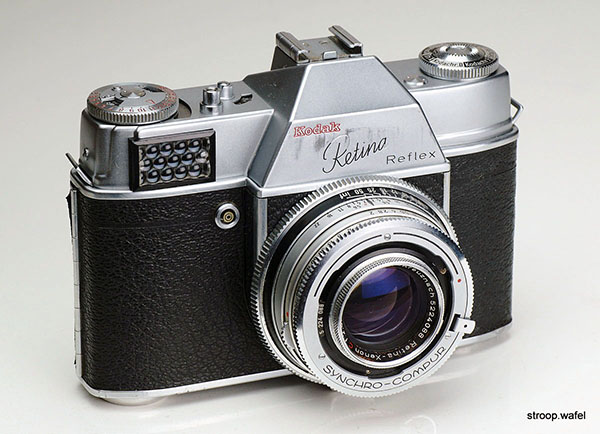
Retina Reflex with Schneider Xenon 50 f/2 lens, the same lens as on the Retina IIIc and IIIC models, and an uncoupled lightmeter.
Kodak Retina Reflex S
This was the second Retina Reflex and the first with the same lens mount as the Retina IIIS, so the lenses were fully intercheangable, not just the front part like on the Retina C lenses. Other than the viewfinder, the handling of this camera was very similar to the IIIS also, including setting the exposure, the frame counter, film wind and rewind. The shutter system was even more complex than the Retina Reflex above. The lens aperture was set to fully open to allow the maximum light through for focusing the lens, independent of what aperture was actually set on the lens. Then, upon pushing the shutter release, the lens aperture would close to the set value, and then go through the same shutter sequence as the Reflex above.
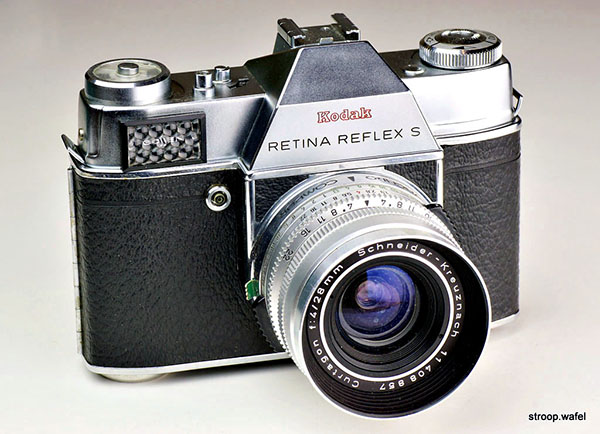
Retina Reflex S with Schneider Curtagon 28mm f/4 lens. The Retina system was one of the few that came with a 28mm wide angle lens in the line-up, which added to its appeal.
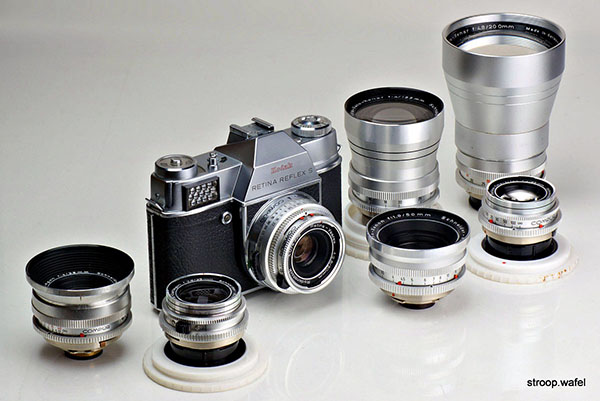
Retina Reflex S with the whole available range of focal lengths from 28mm up to 200mm. Still missing are the Rodenstock versions, as they are generally rare and expensive. I only possess the Ysarex 50/2.8, which can be seen mounted on the camera. (UPDATE: I was lucky enough to get a bargain on a Eurygon 30mm f/2.8, see below).
Just for completion, the lenses are (from left to right) the Retina-Curtagon 28mm f/4, the Retina-Curtagon 35mm f/2.8, the Retina-Xenon 50mm f/1.9, the Retina-Tele-Arton 85mm f/4, the Retina-Tele-Xenar 135/4 and 200/4.8, all from Schneider Kreuznach. The latter lens had a tripod mount as well as filters that could be inserted behind the rear cell. Its minimum focus distance was a whopping 6.5m so you'd really only use it if you had no other means of getting close to the subject!
Kodak Retina Reflex III
The 1961 Reflex III was the next model after the Reflex S. It had a larger lightmeter cell and allowed coupled exposure metering. The lightmeter needle was visible in the viewfinder. The shutter release moved from the top housing to the front of the body. It came with a fast f/1.9 Xenon or slower f/2.8 Xenar lens, or the Rodenstock equivalents, the Heligon and Ysarex.
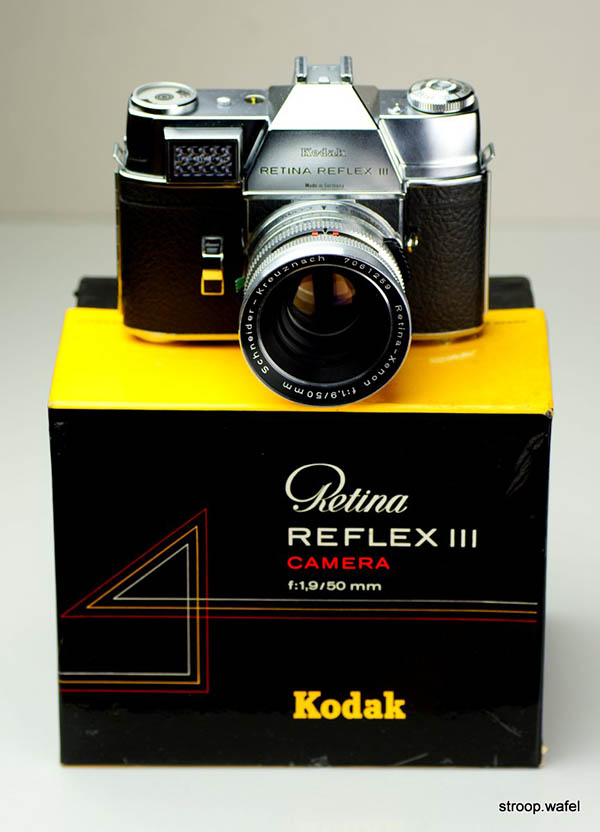
Retina Reflex III with its original box.

Retina Reflex III with Schneider Xenon f/1.9 lens.

Top view of Retina Reflex III showing the coupled lightmeter.
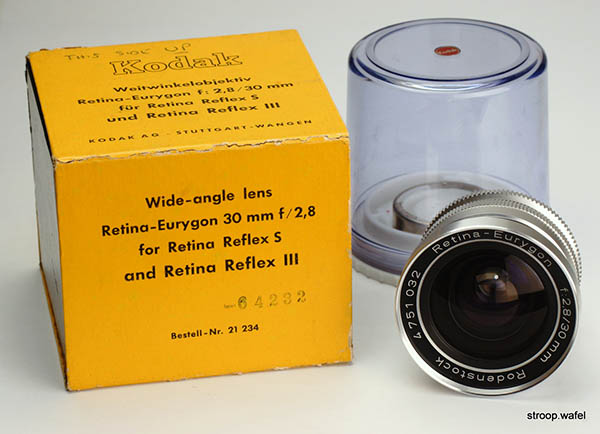
The fastest wide angle lens available for the Retina Reflex and IIIS range was the Rodenstock Eurygon 30mm f/2.8. It's a rather rare and expensive lens nowadays but I was lucky enough to get a good deal on one. Here it is with its original box and holder.

And here is the Eurygon mounted on the Retina Reflex III. It would fit the Retina IIIS as well as it did have a rangefinder cam.
Kodak Retina Reflex IV
The 1964 Reflex IV was essentially an incremental upgrade of the Reflex III. The main new features were a hot shoe, a pop-out rewind lever and a small display in the viewfinder showing the selected aperture and shutter speed settings as well as the lightmeter needle, which allowed the user to select the right exposure and focus the lens without taking their eye of the viewfinder. Some reports indicate that this was by far the most successful Retina Reflex model with over half a million copies sold, but this appears to be due to a simple printing error that has been copied unchecked for decades: the most recent estimate from the highly thorough HSRC indicates only about 52,000 were made, making it the least popular Retina Reflex. Competition from cheaper, lighter focal-plane SLRs from Japan had clearly taken its toll.

Retina Reflex IV with Rodenstock Retina-Rotelar 135mm f/4 lens. The slightly awkward looking window in the middle of the reflex housing imaged the shutter and aperture setting in the viewfinder by means of two small mirrors. The styling of the Reflex IV changed compared to earlier models, with more black lacquered edges and a black release button.
Kodak Instamatic Reflex
Officially the Instamatic Reflex was perhaps not marketed as a Retina but the camera took the same 'S' series lenses as the Retina IIIS and Reflex S, III and IV, so it is worth mentioning here. It was introduced in 1968, around the time the Retina Reflex range was phased out. The Instamatic Reflex was definitively the most advanced (and expensive) camera to use 126 film (Instamatic) cassettes and presumably introduced by Kodak to boost the image of that format. The camera had an automatic exposure system based on a CdS lightmeter (so the camera needed batteries) and the shutter speed was shown in the viewfinder. The camera also had a shoe for flash cubes, which were popular at the time. The shutter was a Compur electronic. It came with Schneider Xenon f/1.9 or Xenar f/2.8 lens, but of course the whole line-up of Retina Reflex lenses could be used on this camera. A black version was also available. Later production had an accessory shoe, which was missing on earlier ones.

Instamatic Reflex with Schneider Curtagon 28mm f/4 lens. This is the later version of this lens, which can focus down to 0.6m (2 ft) but misses the rangefinder cam, so was designed to be used with the Reflex cameras, not the Retina IIIS. The Instamatic was considerably smaller and lighter than the Reflex cameras. Note the large round lightmeter window to the right of the reflex housing.
|

